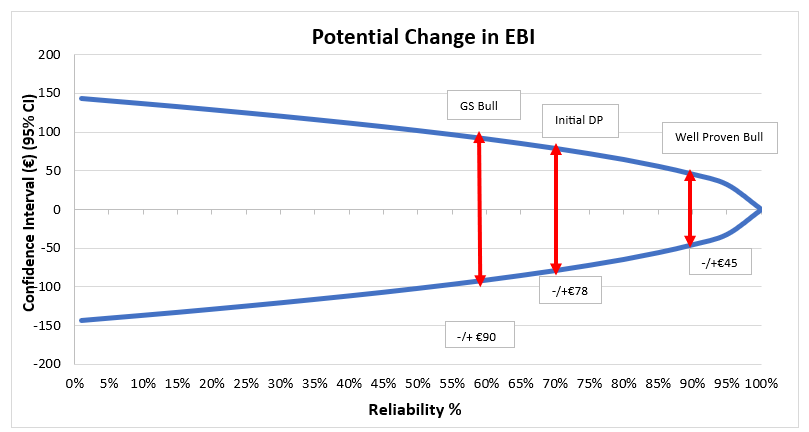Selecting a large team of bulls and ensuring equal usage of your bull team is a critical element to help manage risk in your breeding programme. Analysis of AI sire usage in Irish dairy herds shows an over reliance on certain sires. This is illustrated in table 2. The risk is that if the bull should subsequently fall in EBI, then the genetic merit of the progeny will also be affected. Therefore, using a team of bulls equally on cows and heifers is vital when breeding dairy replacements and to maximise the rate of genetic gain in your herd. The risks of some bulls going up and some bulls going down, evens out and it results in a higher reliability for the overall bull team.
Reliability Explained
The EBI is an estimate of an animal’s genetic potential based on the available performance data, ancestry data and genomic data. The corresponding reliability figure gives an indication of the accuracy or degree of confidence in estimating the breeding values. As the quantity of information available on the animal and/or its relatives increases e.g., such as milk recording records, then the reliability increases as well. The higher the reliability figure, the less likely that the figure will change significantly in the future. Different animals will fall into different reliability ranges depending on the levels of data available for that animal. This is shown in Table 1. The reliability therefore provides information on how much the proof of an individual can vary from the published estimate as more data accumulates.

Confidence Interval
The 95% confidence interval for the EBI of an animal with different reliability values is presented in graph 1. This interval shows where the true breeding values of the animal may lie relative to its published value. With this calculation, we can be 95% confident that the true values fall within the limits of a specific range. In addition, it’s important to note that all bull proofs can change as more information is collected on them, irrespective if the bull has a genomic or daughter proven proof. Proofs can rise or fall as the reliability increases on breeding values. Daughter proven bulls that are proven for milk traits only can still change in the order of -/+ €78. They still have a large amount of genomics contributing to their EBI. As expected, young genomic bull proofs do move more due to lower reliability (e.g., no milk daughter records). Well proven bulls that are proven for both milk and female fertility (reliability of greater than 90%), their EBI can still change in the order +/-€45.

Bull Team Size and Usage 2023
A recent data analysis was completed to assess the current adherence to the principle of bull teams. The analysis was based on dairy herds that had >=10 AI bred dairy calves that were born from 1st January 2023 to the 30th of June 2023. Looking at the data from calves born in table 2 indicates that 8,569 dairy herds had more than 10 AI bred calves born in this period. The average number of bulls used in these herds was 9.6, which is above the minimum number of bulls to use recommended by ICBF and Teagasc to help manage risk in your breeding season. This is really an encouraging trend. However, the most heavily used AI bulls in these herds accounting for 29% of the total calves born. This is significantly above the recommended usage by Teagasc and ICBF, where no more than 15% of mating should exceed to any one bull. The three most heavily used bulls sired 62% of the calves born while 70% of the herds used greater or equal the minimum number of AI bulls recommended. These metrics need to be improved going forward to maximise the benefits of genomic technology and to deliver maximum EBI gain for Irish farmers.

Bull Team Guidelines
The best breeding policy for farmers is to use a team of bulls equally across the herd. Variability is also a key factor to increase genetic gain. The bull team usage guidelines are presented in table 3. Any bull team should consist of at least 7 bulls. For herds greater than 150 cows, this number needs to increased. The benefit of using a team of bulls is that the reliability of the average genetic merit of the team is considerably greater than the reliability of each individual bull.

Bull team strategies will help manage risk when breeding your next generation of heifers. The sire advice application is one potential tool which can be used to mitigate risk during the breeding season and ensure the equal usage of the bull team. This online tool mates selected AI bulls to animals in a herd and outputs this to a breeding chart or Technician handheld. It automatically prevents inbreeding while maximising genetic gain and minimising the variation between production and fertility.
